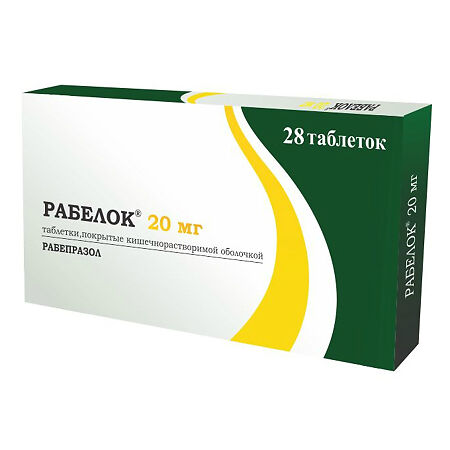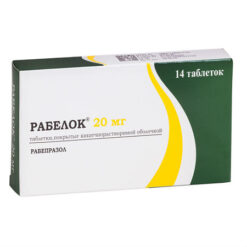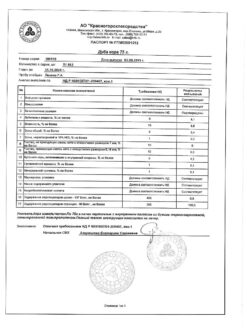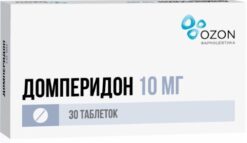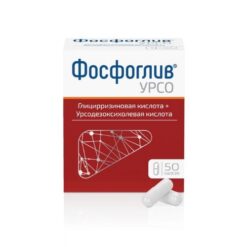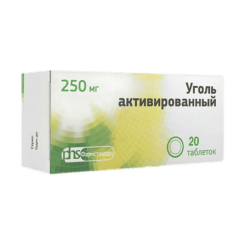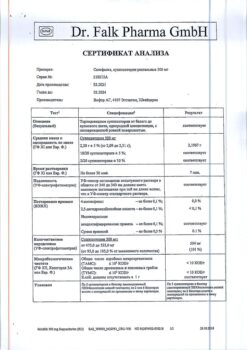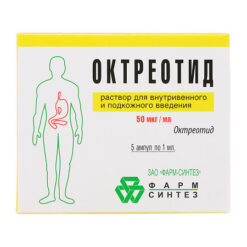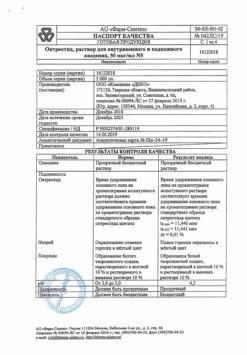No products in the cart.
Rabelock, 20 mg 28 pcs.
€22008.00 €18.34
EAN: 8901149031783
SKU: 492867
Categories: Medicine, Stomach, intestines, liver, Ulcer and gastritis
Description
Pharmacotherapeutic group: gastric gland secretion reducing agent – proton pump inhibitor.
The ATX code: A02BC04
Pharmacological properties
Pharmacodynamics
Mechanism of action
Rabeprazole sodium belongs to the class of antisecretory agents, benzimidazole derivatives. Rabeprazole sodium inhibits gastric juice secretion by specifically inhibiting H+/K+ATPase on the secretory surface of gastric parietal cells.
H+/K+ATPase is a protein complex that functions as a proton pump, thus rabeprazole sodium is a proton pump inhibitor in the stomach and blocks the final stage of acid production.
This effect is dose-dependent and results in suppression of both basal and stimulated acid secretion regardless of the stimulus. Rabeprazole sodium has no anticholinergic properties.
Antisecretory effects
After oral administration of 20 mg of rabeprazole sodium, the antisecretory effect develops within one hour. Inhibition of basal and stimulated acid secretion 23 hours after the first dose of rabeprazole sodium is 69% and 82%, respectively, and lasts up to 48 hours.
This duration of pharmacodynamic action is much longer than that predicted by the half-life (approximately one hour). This effect may be explained by prolonged binding of the drug substance to H+/ K+ATPase of gastric parietal cells.
The magnitude of the inhibitory effect of rabeprazole sodium on acid secretion reaches a plateau after three days of taking rabeprazole sodium. When discontinued, secretory activity is restored within 1-2 days.
The effect on plasma gastrin levels
In clinical studies, patients were treated with 10 or 20 mg of rabeprazole sodium daily for a treatment duration of up to 43 months. Plasma gastrin levels were elevated for the first 2 to 8 weeks, reflecting an inhibitory effect on acid secretion.
Gastrin concentrations returned to baseline levels usually within 1 to 2 weeks after discontinuation of treatment.
The effect on enterochromaffin-like cells
. In a study of human gastric biopsy specimens from the antrum and gastric fundus of 500 patients treated with rabeprazole sodium or a comparison drug for 8 weeks, no consistent changes were found in the morphological structure of enterochromaffin-like cells, gastritis severity, frequency of atrophic gastritis, intestinal metaplasia or the spread of Helicobacterpylori infection.
In a study involving more than 400 patients receiving rabeprazole sodium (10 mg/day or 20 mg/day) for up to 1 year, the incidence of hyperplasia was low and comparable to that of omeprazole (20 mg/kg). No cases of adenomatous changes or carcinoid tumors were reported in rats.
Systemic effects of rabeprazole sodium on the central nervous system, cardiovascular or respiratory systems have not been detected at this time.
Rabeprazole sodium has been shown to have no effect on thyroid function, carbohydrate metabolism, blood levels of parathyroid hormone, and levels of cortisol, estrogen, testosterone, prolactin, glucagon, follicle stimulating hormone (FSH), luteinizing hormone (LH), renin, aldosterone and somatotropic hormone when taken orally in a dose of 20 mg for 2 weeks.
Pharmacokinetics
Absorption
Rabeprazole is rapidly absorbed from the gut, and its peak plasma concentrations are reached approximately 3.5 h after a 20 mg dose. Changes in peak plasma concentrations (Cma) and values of area under the concentration-time curve (AUC) of rabeprazole are linear in the dose range from 10 to 40 mg.
The absolute bioavailability after oral administration of 20 mg (compared to intravenous administration) is about 52%.
In addition, bioavailability does not change with repeated administration of rabeprazole. In healthy volunteers, the plasma elimination half-life is about 1 h (varying from 0.7 to 1.5 h) and total clearance is 3.8 ml/min/kg.
In patients with chronic liver damage, the AUC is doubled compared to healthy volunteers, indicating decreased first-pass metabolism, and the plasma elimination half-life is increased by 2 to 3 times.
Neither the time of intake of the drug during the day, nor antacids affect absorption of rabeprazole. Taking the drug with fatty foods slows down absorption of rabeprazole by 4 hours or more, but neither Cmah nor the degree of absorption is changed.
Distribution
In humans, the degree of binding of rabeprazole to plasma proteins is about 97%.
Metabolism and excretion
In healthy subjects
After a single oral dose of 20 mg 14C-labeled sodium rabeprazole, no unchanged drug was found in the urine. About 90% of rabeprazole is excreted in the urine mainly as two metabolites: conjugatamercapturic acid (M5) and carboxylic acid (M6), and in the form of two unknown metabolites identified in the toxicological analysis. The remainder of rabeprazole sodium taken is excreted in the feces.
The total excretion is 99.8%. These data indicate a small excretion of metabolites of sodium rabeprazole with bile. The main metabolite is thioether (M1). The only active metabolite is desmethyl (M3), but it was observed in low concentration only in one study participant after administration of 80 mg of rabeprazole.
Terminal renal failure
In patients with stable, terminal renal failure who require maintenance hemodialysis (creatinine clearance <5 ml/min/1.73m2), the excretion of rabeprazole sodium is similar to that of healthy volunteers. The AUC and Cmax in these patients were approximately 35% lower than in healthy volunteers.
The mean half-life of rabeprazole was 0.82 h in healthy volunteers, 0.95 h in patients during hemodialysis, and 3.6 h after hemodialysis. Clearance of the drug in patients with kidney disease requiring hemodialysis was approximately twice as high as in healthy volunteers.
Chronic compensated cirrhosis
Patients with chronic compensated cirrhosis tolerate rabeprazole sodium at a dose of 20 mg once daily, although AUC is doubled and Cmax is increased by 50% compared to healthy volunteers of the respective sex.
Elderly patients
In elderly patients, elimination of rabeprazole is somewhat delayed. After 7 days of taking rabeprazole at 20 mg daily, the AUC was approximately twice as high and the Cmax was increased by 60% compared to young healthy volunteers. However, no evidence of rabeprazole cumulation was observed.
CYP2C19 polymorphism
. In patients with delayed CYP2C19 metabolism after 7 days of taking rabeprazole at a dose of 20 mg per day, the AUC is increased 1.9-fold and the elimination half-life 1.6-fold compared to the same parameters in “fast metabolizers”, while Cmax is increased by 40%.
Indications
Indications
– Gastric ulcer in the acute stage and anastomotic ulcer;
– duodenal ulcer in the acute stage;
– erosive and ulcerative gastroesophageal reflux disease or reflux esophagitis;
– maintenance therapy of gastroesophageal reflux disease;
– non-erosive gastroesophageal reflux disease;
– Zollinger-Ellison syndrome and other conditions characterized by pathological hypersecretion.
As part of combination therapy:
– eradication of Helicobacter pylori in patients with peptic ulcer.
Pharmacological effect
Pharmacological effect
Pharmacotherapeutic group: a drug that reduces the secretion of gastric glands – a proton pump inhibitor.
ATX code: A02BC04
Pharmacological properties
Pharmacodynamics
Mechanism of action
Rabeprazole sodium belongs to the class of antisecretory substances, benzimidazole derivatives. Rabeprazole sodium suppresses gastric acid secretion by specifically inhibiting H+/K+ ATPase on the secretory surface of gastric parietal cells.
H+/K+ATPase is a protein complex that functions as a proton pump, thus rabeprazole sodium is an inhibitor of the proton pump in the stomach and blocks the final stage of acid production.
This effect is dose-dependent and leads to suppression of both basal and stimulated acid secretion, regardless of the stimulus. Rabeprazole sodium does not have anticholinergic properties.
Antisecretory action
After oral administration of 20 mg of rabeprazole sodium, the antisecretory effect develops within an hour. Inhibition of basal and stimulated acid secretion 23 hours after taking the first dose of rabeprazole sodium is 69% and 82%, respectively, and lasts up to 48 hours.
This duration of pharmacodynamic action far exceeds that predicted by the half-life (approximately one hour). This effect can be explained by the prolonged binding of the drug to the H+/K+ ATPase of gastric parietal cells.
The magnitude of the inhibitory effect of rabeprazole sodium on acid secretion reaches a plateau after three days of taking rabeprazole sodium. When you stop taking it, secretory activity is restored within 1-2 days.
Effect on plasma gastrin levels
In clinical studies, patients took 10 or 20 mg of rabeprazole sodium daily for treatment durations of up to 43 months. Plasma gastrin levels were elevated in the first 2–8 weeks, reflecting an inhibitory effect on acid secretion.
Gastrin concentrations returned to baseline levels usually within 1-2 weeks after cessation of treatment.
Effect on enterochromaffin-like cells
In a study of human gastric biopsy specimens from the antrum and fundus of 500 patients treated with rabeprazole sodium or a comparator for 8 weeks, no consistent changes were found in the morphological structure of enterochromaffin-like cells, the severity of gastritis, the incidence of atrophic gastritis, intestinal metaplasia or the prevalence of Helicobacter pylori infection.
In a study of more than 400 patients treated with rabeprazole sodium (10 mg/day or 20 mg/day) for up to 1 year, the incidence of hyperplasia was low and comparable to that of omeprazole (20 mg/kg). There have been no reported cases of adenomatous changes or carcinoid tumors observed in rats.
Other effects
Systemic effects of rabeprazole sodium on the central nervous system, cardiovascular or respiratory systems have not currently been detected.
It has been shown that rabeprazole sodium, when taken orally at a dose of 20 mg for 2 weeks, has no effect on thyroid function, carbohydrate metabolism, the level of parathyroid hormone in the blood, as well as on the levels of cortisol, estrogens, testosterone, prolactin, glucagon, follicle-stimulating hormone (FSH), luteinizing hormone (LH), renin, aldosterone and somatotropic hormone.
Pharmacokinetics
Absorption
Rabeprazole is rapidly absorbed from the intestine and peak plasma concentrations are achieved approximately 3.5 hours after a 20 mg dose. Changes in peak plasma concentrations (Cmax) and area under the concentration-time curve (AUC) of rabeprazole are linear in the dose range from 10 to 40 mg.
Absolute bioavailability after oral administration of 20 mg (compared to intravenous administration) is approximately 52%.
In addition, bioavailability does not change with repeated dosing of rabeprazole. In healthy volunteers, the plasma half-life is approximately 1 hour (ranging from 0.7 to 1.5 hours) and the total clearance is 3.8 ml/min/kg.
In patients with chronic liver damage, the AUC is doubled compared to healthy volunteers, indicating a decrease in first-pass metabolism, and the plasma half-life is increased by 2-3 times.
Neither the time of taking the drug during the day nor antacids affect the absorption of rabeprazole. Taking the drug with fatty foods slows down the absorption of rabeprazole by 4 hours or more, but neither Cmax nor the degree of absorption changes.
Distribution
In humans, the degree of binding of rabeprazole to plasma proteins is about 97%.
Metabolism and excretion
In healthy people
After taking a single oral dose of 20 mg of 14C-labeled rabeprazole sodium, no unchanged drug was found in the urine. About 90% of rabeprazole is excreted in the urine mainly in the form of two metabolites: conjugate mercapturic acid (M5) and carboxylic acid (M6), as well as in the form of two unknown metabolites identified during toxicological analysis. The remainder of the rabeprazole sodium taken is excreted in the feces.
The total elimination is 99.8%. These data indicate a small excretion of rabeprazole sodium metabolites in bile. The main metabolite is thioester (M1). The only active metabolite is desmethyl (M3), but this was observed at low concentrations in only one study participant after taking 80 mg rabeprazole.
End stage renal failure
In patients with stable end-stage renal disease who require maintenance hemodialysis (creatinine clearance <5 ml/min/1.73 m2), the elimination of rabeprazole sodium is similar to that of healthy volunteers. AUC and Cmax in these patients were approximately 35% lower than in healthy volunteers.
The average half-life of rabeprazole was 0.82 hours in healthy volunteers, 0.95 hours in patients undergoing hemodialysis, and 3.6 hours after hemodialysis. Clearance of the drug in patients with kidney disease requiring hemodialysis was approximately twice as high as in healthy volunteers.
Chronic compensated cirrhosis
Patients with chronic compensated liver cirrhosis tolerate rabeprazole sodium at a dose of 20 mg 1 time per day, although the AUC is doubled and Cmax is increased by 50% compared to healthy volunteers of the same sex.
Elderly patients
In elderly patients, the elimination of rabeprazole is somewhat slower. After 7 days of taking rabeprazole 20 mg per day in elderly individuals, the AUC was approximately twice as high and Cmax was increased by 60% compared to young healthy volunteers. However, there were no signs of rabeprazole accumulation.
CYP2C19 polymorphism
In patients with slow metabolism of CYP2C19, after 7 days of taking rabeprazole at a dose of 20 mg per day, the AUC increases by 1.9 times and the half-life by 1.6 times compared with the same parameters in “rapid metabolizers,” while Cmax increases by 40%.
Special instructions
Special instructions
The patient’s response to therapy with rabeprazole sodium does not exclude the presence of malignant neoplasms in the stomach. Rabeloc® tablets should not be chewed or crushed. The tablets should be swallowed whole. It has been established that neither time of day nor food intake affects the activity of rabeprazole sodium.
In a special study in patients with mild or moderate liver dysfunction, there was no significant difference in the incidence of side effects of the drug Rabeloc® from that in healthy individuals matched by sex and age, but despite this, caution is recommended when first prescribing Rabelock® to patients with severe liver dysfunction. The AUC of rabeprazole sodium in patients with severe hepatic impairment is approximately two times higher than in healthy patients.
For patients with impaired renal or liver function, dose adjustment of Rabeloc® is not required.
Hypomagnesemia
When treated with proton pump inhibitors for at least 3 months, cases of symptomatic or asymptomatic hypomagnesemia have been reported in rare cases. In most cases, these reports were received one year after therapy.
Serious adverse events included tetany, arrhythmia, and seizures. Most patients required treatment for hypomagnesemia, including magnesium replacement and discontinuation of proton pump inhibitor therapy. In patients who will be receiving long-term treatment or who are taking proton pump inhibitors with drugs such as digoxin or drugs that can cause hypomagnesemia (eg, diuretics), healthcare providers should monitor magnesium levels before starting treatment with proton pump inhibitors and during treatment.
Patients should not take other acid-reducing agents, such as H2 receptor blockers or proton pump inhibitors, at the same time as Rabeloc®.
Bone fractures
Observational studies suggest that proton pump inhibitor (PPI) therapy may increase the risk of osteoporosis-related fractures of the hip, wrist, or spine. The risk of fractures was increased in patients receiving high doses of PPIs for a long time (a year or more).
Concomitant use of rabeprazole with methotrexate
According to the literature, simultaneous use of PPIs with methotrexate (primarily in high doses) can lead to increased concentrations of methotrexate and/or its metabolite hydroxymethotrexate and increase the half-life, which can lead to methotrexate toxicity. If high doses of methotrexate are necessary, temporary discontinuation of PPI therapy may be considered.
Clostridium difficile
PPI therapy may lead to an increased risk of gastrointestinal infections such as Clostridium difficile.
Subacute cutaneous lupus erythematosus (SCLE)
There are reports of cases of PCLE during PPI therapy. If skin lesions appear, especially on areas of skin exposed to direct sunlight, and are accompanied by arthralgia, the patient should immediately seek medical attention and the health care professional should decide to discontinue rabeprazole therapy.
The occurrence of PCLE with previous PPI therapy may increase the risk of PCLE with other PPIs.
Glandular polyps of the fundus of the stomach
Long-term use of PPIs, including rabeprazole, appears to be associated with an increased risk of fundal glandular polyps. Most glandular polyps of the fundus of the stomach are asymptomatic. Patients with large or ulcerated polyps may be at risk for gastrointestinal bleeding or small bowel obstruction.
The dosage and duration of PPI therapy for such patients should be kept to a minimum.
Impact on the ability to drive vehicles and machinery
Based on the characteristics of the pharmacodynamics of beprazole and its profile of undesirable effects, it is unlikely that the drug Rabeloc® affects the ability to drive vehicles and machinery. However, if drowsiness occurs, these activities should be avoided.
Active ingredient
Active ingredient
Rabeprazole
Composition
Composition
1 tablet contains:
Active substance: rabeprazole sodium 20 mg.
Excipients: mannitol 89.0 mg; magnesium oxide 80.0 mg; hypromellose 5.0 mg; microcrystalline cellulose 20.0 mg; starch 20.0 mg; carmellose 20.0 mg; talc 3.0 mg; magnesium stearate 6.0 mg; colloidal silicon dioxide 3.0 mg.
Shell: hypromellose 9.5 mg; propylene glycol 1.5 mg;
Enteric
shell: methacrylic acid and ethyl acrylate copolymer (type C)
(1:1) 13.95 mg; polysorbate 80 0.209 mg; dibutyl phthalate 2.090 mg; sodium
hydroxide 0.119 mg; iron oxide yellow dye 0.783 mg; talc 5.63 mg;
titanium dioxide 1.210 mg.
Pregnancy
Pregnancy
There are no data on the safety of rabeprazole during pregnancy. Reproduction studies in rats and rabbits showed no evidence of impaired fertility or fetal developmental defects associated with rabeprazole; however, in rats the drug crosses the placental barrier in small quantities.
Rabeloc® should not be used during pregnancy unless the expected positive effect for the mother outweighs the possible harm to the fetus.
It is not known whether rabeprazole is excreted in breast milk. Appropriate studies have not been conducted in lactating women. At the same time, rabeprazole was found in the milk of lactating rats, and therefore Rabeloc®
should not be prescribed to nursing women.
Contraindications
Contraindications
Individual hypersensitivity to rabeprazole, substituted benzimidazoles or auxiliary components of the drug, pregnancy, breastfeeding, children under 12 years of age.
With caution
Severe renal failure, severe liver failure,
children’s age from 12 to 18 years.
Side Effects
Side Effects
Based on the experience of clinical studies, it can be concluded that rabeprazole is usually well tolerated by patients. Side effects, generally mild or moderate, are transient. When taking rabeprazole in clinical studies, the following side effects were observed: headache, abdominal pain, diarrhea, flatulence, constipation, dry mouth, dizziness, rash, peripheral edema.
Adverse reactions are systematized for each organ system using the following frequency classification: very common (>1/10); often (>1/100 and 1/1000 and 1/10000 and <1/1000); very rare (<1/10000), including isolated cases.
Immune system disorders: rarely – acute systemic allergic reactions.
Disorders of the blood and lymphatic system: rarely – thrombocytopenia, neutropenia, leukopenia.
Metabolic and nutritional disorders: rarely – hypomagnesemia.
Disorders of the liver and biliary tract: increased activity of liver enzymes, rarely – hepatitis, jaundice, hepatic encephalopathy.
Renal and urinary tract disorders: very rarely – interstitial nephritis.
Disorders of the skin and subcutaneous tissues: rarely – bullous rashes, urticaria, very rarely – erythema multiforme, toxic epidermal necrolysis, Stevens-Johnson syndrome.
Musculoskeletal and connective tissue disorders: rarely – myalgia, arthralgia.
Disorders of the genital organs and mammary gland: very rarely – gynecomastia.
No changes in other laboratory parameters were observed while taking rabeprazole sodium.
According to post-marketing observations,
Taking proton pump inhibitors (PPIs) may increase the risk
occurrence of fractures, subacute cutaneous lupus erythematosus and glandular polyps
fundus of the stomach (see section “Special Instructions”). Rare reports of hepatic
encephalopathies have been reported in patients with cirrhosis.
Interaction
Interaction
Cytochrome 450 system
Rabeprazole sodium, like other proton pump inhibitors (PPIs), is metabolized by the cytochrome P450 (CYP450) system in the liver. In vitro studies on human liver microsomes showed that rabeprazole sodium is metabolized by the isoenzymes CYP2C19 and CYP3A4.
Studies in healthy volunteers have shown that rabeprazole sodium has no pharmacokinetic or clinically significant interactions with drugs that are metabolized by the cytochrome P450 system – warfarin, phenytoin, theophylline and diazepam (regardless of whether patients metabolize diazepam extensively or poorly).
A study of combination therapy with antibacterial drugs was conducted. This four-way crossover study involved 16 healthy volunteers who received rabeprazole 20 mg, amoxicillin 1000 mg, clarithromycin 500 mg, or a combination of these three drugs (RAC – rabeprazole, amoxicillin, clarithromycin).
AUC and Cmax values for clarithromycin and amoxicillin were similar when combination therapy was compared with monotherapy. The AUC and Cmax for rabeprazole increased by 11% and 34%, respectively, and for 14-hydroxy-clarithromycin (the active metabolite of clarithromycin), the AUC and Cmax increased by 42% and 46%, respectively, for combination therapy compared with monotherapy.
This increase in exposure rates for rabeprazole and clarithromycin was not considered clinically significant.
Interactions due to inhibition of gastric acid secretion
Rabeprazole sodium provides a stable and long-lasting suppression of gastric acid secretion. Thus, interactions may occur with substances for which absorption is pH dependent. When taken simultaneously with rabeprazole sodium, the absorption of ketoconazole is reduced by 30%, and the absorption of digoxin is increased by 22%.
Therefore, some patients should be monitored to determine whether dose adjustments are necessary when taking rabeprazole sodium concomitantly with ketoconazole, digoxin, or other drugs for which absorption is pH dependent.
Atazanavir
When atazanavir 300 mg/ritonavir 100 mg was coadministered with omeprazole (40 mg once daily) or atazanavir 400 mg with lansoprazole (60 mg once daily) in healthy volunteers, a significant reduction in atazanavir exposure was observed.
Absorption of atazanavir is pH dependent. Although concomitant use with rabeprazole has not been studied, similar results are expected for other proton pump inhibitors. Therefore, concomitant use of atazanavir with proton pump inhibitors, including rabeprazole, is not recommended.
Antacids
In clinical studies, antacid substances were used in conjunction with rabeprazole sodium. Clinically significant interactions of rabeprazole sodium with aluminum hydroxide gel or magnesium hydroxide were not observed.
Eating
In a clinical study, no clinically significant interactions were observed when rabeprazole sodium was taken with a low-fat meal. Taking rabeprazole sodium simultaneously with a fat-enriched meal may slow down the absorption of rabeprazole by up to 4 hours or more, but Cmax and AUC do not change.
Cyclosporine
In vitro experiments using human liver microsomes showed that rabeprazole inhibits the metabolism of cyclosporine with an IC50 of 62 μmol, i.e., at a concentration 50 times the Cmax for healthy volunteers after 14 days of administration of 20 mg rabeprazole. The degree of inhibition is similar to that of omeprazole for equivalent concentrations.
Methotrexate
Adverse event reports, published pharmacokinetic studies, and retrospective analyzes suggest that concomitant use of PPIs and methotrexate (primarily at high doses) may result in increased concentrations of methotrexate and/or its metabolite hydroxymethotrexate and prolong the half-life.
However, no specific drug interaction studies have been conducted between methotrexate and PPIs.
Impact on laboratory results
The use of PPIs leads to a decrease in gastric acidity, which can lead to an increase in serum chromogranin A (CgA). Elevated CgA levels may lead to misinterpretation of laboratory results for the presence of a neuroendocrine tumor.
To avoid this effect, use the drug Rabelok®
must be temporarily discontinued at least 14 days before the level assessment
CgA; repeating the test should be considered if the initial CgA level
is high.
Overdose
Overdose
Symptoms. Information about overdose is minimal. It has been reported to take rabeprazole at a dose of 60 mg 2 times a day and 160 mg once. Side effects were minimal and did not require medical intervention.
Treatment. A specific antidote is unknown. Rabeprazole binds well to plasma proteins and is therefore poorly excreted during dialysis.
In case of overdose, symptomatic treatment is necessary.
Storage conditions
Storage conditions
In a dry place, protected from light, at a temperature not exceeding 25 ° C.
Keep out of the reach of children!
Shelf life
Shelf life
2 years.
Manufacturer
Manufacturer
Cadila Pharmaceuticals Ltd, India
Additional information
| Shelf life | 2 years. |
|---|---|
| Conditions of storage | In a dry place protected from light at a temperature not exceeding 25 ° C. Keep out of reach of children! |
| Medication form | enteric-soluble film-coated tablets |
Other forms…
Related products
Buy Rabelock, 20 mg 28 pcs. with delivery to USA, UK, Europe and over 120 other countries.

